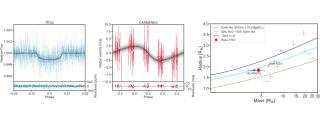We explore the stellar initial mass function (IMF) of a sample of 49massive quiescent galaxies (MQGs) at 0.9<z<1.5. We base our analysis on intermediate resolution spectro-photometric data in theGOODS-N field taken in the near-infrared and optical with the HST/WFC3 G141 grism and the Survey for High-z Absorption Red andDead Sources (SHARDS). To constrain the slope of the IMF, we havemeasured the TiO2 spectral feature, whose strength depends strongly on the content of low-mass stars, as well as on stellar age. Usingultraviolet to near-infrared individual and stacked spectral energydistributions, we have independently estimated the stellar ages of ourgalaxies. Knowing the age of the stellar population, we interpret thestrong differences in the TiO2 feature as an IMF variation. In particular,for the heaviest z~1 MQGs (M>10^11.0 Msun) we find an average age of1.7+/-0.3 Gyr and a bottom-heavy IMF (Gamma=3.2+/-0.2). LighterMQGs (10^10.3<M<10^11.0 Msun) at the same redshift are younger onaverage (1.0+/-0.2 Gyr) and present a shallower IMF slopeGamma=2.7+/-0.3).
Our results are in good agreement with the findings about the IMF slope in early-type galaxies of similar mass in the present-day Universe. This suggests that the IMF, a key characteristic of the stellar populations in galaxies, is bottom-heavier for more massive galaxies and has remained unchanged in the last ~8 Gyr.


